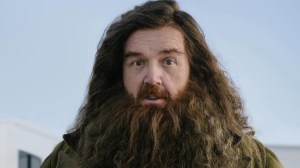The first The Invisible Man landed in theaters back in 1933 and, unlike other horror figures such as Dracula or Frankenstein’s Monster, the titular character hasn’t made as many appearances over the years, with this weekend’s remake sure to leave some audiences wondering how it compares to the original. From the project’s first announcement, writer/director Leigh Whannell confirmed that the film would be deviating from the source material, with the film’s release in theaters now making it clear just how far removed from its source material it is, other than with its name. For those unfamiliar with the source material, we’re here to let you know just how different this new film is from its origins.
Videos by ComicBook.com
WARNING: Mild spoilers below for The Invisible Man
In both the 1897 novel from H.G. Wells and the 1933 film, we focus on the character Griffin and his discovery of rendering himself invisible. In both stories, his motivations are largely to make an astounding discovery as opposed to having a practical use for such powers, while the film adds into the narrative that he is motivated by a rival student and aims to prove his worth at their medical school.
In this year’s film, the titular character is an expert in optics and, rather than physically rendering himself invisible, has developed a suit that uses a variety of cameras and projections that create the illusion of invisibility. What makes this film so different from its predecessors is that Adrian (Oliver Jackson-Cohen) can take the suit on and off, while previous stories were intrinsically linked with the idea that these characters couldn’t reverse their transition to invisibility.
In earlier stories, it was the inability to become visible that tied into Griffin’s nefarious nature. In the novel, Griffin’s discovery of his newfound abilities sees him actively deciding to pursue a life of crime and create a “Reign of Terror,” while in the film, one of the chemicals used to turn him invisible was proven to drive dogs mad, which ultimately leads him towards madness.
A major change that this year’s remake utilizes is the overall premise, as well as Adrian’s villainy. Rather than using the title character as the protagonist, the film instead focuses on Cecilia (Elisabeth Moss), who opens the film with an escape from boyfriend Adrian. After her escape, she details the lengths of his emotional and physical abuse against her, which is completely unrelated to his scientific prowess. However, we never actually see this abuse occur, instead relying on Cecilia’s recounting of such behavior. After Adrian fakes his own death, he uses his invisibility suit to continue to torment Cecilia in a variety of ways as she details his narcissistic and sociopathic behavior, which he could more effectively demonstrate with the help of the invisibility suit.
From a filmmaking perspective, this year’s film leans much more into the horrifying premise of being tormented by an unseen force, with a number of the sequences unfolding more like a haunted house film than a story about how a man utilizes the powers of invisibility. Previous incarnations of such a story offer conceptually unnerving ideas, while this film fully unleashes the inherent terror of the premise. Additionally, other films about invisible characters typically aim to highlight the special effects necessary to convey that effect, with the 1933 film famously including a scene where a character unwraps his bandaged head to reveal nothing underneath. While this remake does offer such special effects showcases, they are largely reserved for the film’s final act, as the complete lack of awareness of the character’s location in a scene makes for a much more frightening experience than witnessing a tease of where they might be.
In the case of many remakes and reboots, it’s often easier to call attention to the ways in which an updated take on a concept is different from its source material, but in the case of The Invisible Man, there are very few connections to what inspired it. While there are countless differences with this reimagination, writer/director Whannell still managed to find ways to create parallels between this story and those that came before it.
The Invisible Man is in theaters now.
Did you like the changes the film made to the original concept? Let us know in the comments below or contact Patrick Cavanaugh directly on Twitter to talk all things horror and Star Wars!









